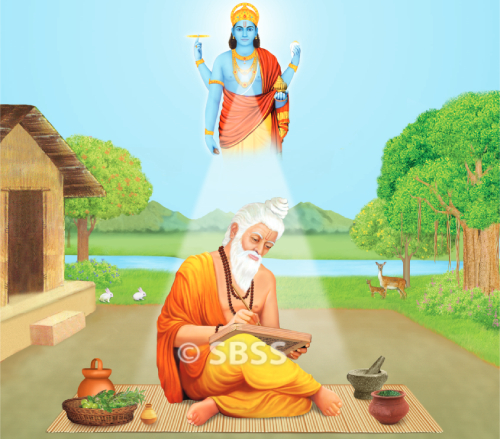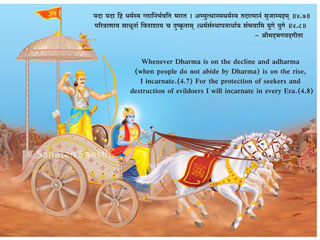Ayurveda for a healthy life ! – 7/2023


Diet and the mind
अन्नमशितं त्रेधा किधीयते । तस्य यः स्थकिष्ठो धातुस्तत्पुरीषं भकति ।
यो मध्यमस्तन्माँसं योऽणिष्ठस्तन्मनः ।
– Chandogya Upanishad (6.5.1)
The Chandogya Upanishad states that the food we eat gets divided into three parts. The undigested solids are converted into faeces. The food which is absorbed into blood after digestion is converted into muscles and various tissues. The subtle, that is, very minute particles of food, form the mind.
The subtle particles of food are the particles of Sattva (One of the three basic components in the Universe, signified by purity & knowledge), Raja (One of the three basic components in the Universe, signified by activity & passion) and Tama (One of the three basic components in the Universe, signified by inertia & ignorance) which are the components of our mind. Therefore, our thoughts and behaviour change with our diet. A diet which increases the Sattva component is called a sattvik diet, while a diet which increases the Raja and Tama components of the mind, is called a rajasik and tamasik diet, respectively.
1. Sattvik, rajasik and tamasik diet ((Food that increase Sattva, Raja and Tama)
1A. Sattvik diet : It is juicy, oily, stable (Sthir) and tasty and pleasurable (Hrudya).
Juicy (Rasya) : Juicy fruits and liquids
Lubricating and nourishing (Snigdha) : Milk, butter and ghee prepared from cow’s milk, act as lubricating agents and nourish the tissues of the body.
Stable (Sthir) : Food items such as dry fruits such as almonds, walnuts, pistas which can be stored and do not putrefy or ferment.
Tasty and pleasurable (Hrudya) : A sattvik diet promotes life, health, physical and mental strength, happiness and love.
आयुः सत्त्वबलारोग्यसुखप्रीतिविवर्धनाः ।
रस्याः स्निग्धाः स्थिरा हृद्या आहाराः सात्त्विकप्रियाः ॥
– Shrimadbhagwadgeeta (17.8)
Sattvik people prefer a sattvik diet, which in turn promotes the Sattva component of the mind.
1B. Rajasik diet : Pungent, sour, salty, very hot, dry & fermented food items increase the Raja component of the mind. Rajasik people prefer this type of food. It gives rise to sorrow, disease
and unhappiness.
कट्वम्ललवणात्युष्णतीक्ष्णरूक्षविदाहिनः ।
आहारा राजसस्येष्टा दुःखशोकामयप्रदाः ॥
– Shrimadbhagwadgeeta (17.9)
1C. Tamasik diet : Stale, tasteless and putrefied diet which is eaten by others, leftover food and a diet which affects the mind, such as alcohol increase the Tama component of the mind. Tamasik people prefer such type of food. It subdues the strength of the brain, mind and intellect.
यातयामं गतरसं पूति पर्युषितं च यत् ।
उच्छिष्टमपि चामेध्यं भोजनं तामसप्रियम् ॥
– Shrimadbhagwadgeeta (17.10)
1D. Examples of sattvik, rajasik and tamasik food items
1. Ripe fruits are sattvik. Pickles made from fruits are rajasik. Alcoholic beverages and wine made from fruits are tamasik.
2. Food offered by wicked people is tamasik, that offered by relatives and friends is rajasik while food offered by Saints is sattvik.
3. Food eaten along with alcohol is tamasik. Food eaten while chatting with friends is rajasik and that eaten while chanting God’s Name is sattvik.
4. Food given by an enemy, an unhappy person, wicked people or prostitutes or food eaten at their place, is tamasik and promotes the Tama component. Food served in hotels or at a marriage is rajasik, while food served as a Prasad of God and that given by Saints is sattvik.
5. Pure food makes the mind pure.
6. Food is digested easily when one is in a happy state of mind. If an individual is full of tension, sorrow, fear or anger, the food is not digested easily. If an individual does not get adequate sleep then also the food is not digested.
मात्रया अपि अभ्यवहृतं पथ्यं चान्नं न जीर्यति ।
चिन्ता शोक भय क्रोध दुःख शय्या प्रजागरैः ॥
– Charaksanhita, Vimansthan (2.9)
7. Sattvik people take an appropriate and adequate diet. Rajasik people eat tasty dishes, till their stomach is full. Tamasik people do not have control over their taste buds and hence, they overeat.
1E. Non-vegetarian diet
न मांसभक्षणे दोषो न मद्ये न च मैथुने ।
प्रवृत्तिरेषा भूतानां निवृत्तिस्तु महाफला ।
– Manusmruti (5.56)
In the Manusmruti, Manu states that eating meat, drinking wine or indulging in sex is not sinful, as these are the natural tendencies of human beings. But those who refrain from indulging in these get good returns.
Ayurveda does not disapprove of eating a non-vegetarian diet. In fact, in diseases wherein there is weakness, wasting of muscles and loss of weight, Ayurveda advises one to eat meat. In tuberculosis, one should eat meat of many animals because the main aim of Ayurveda is to have a healthy and strong body. Only if one is physically strong can one follow the rules laid down by religion and undertake spiritual practice. The poet Kalidas says, ‘शरीरमाद्यं खलु धर्मसाधनम् ॥’.
2. Respect for food
Our body and the food we eat are formed from the Panchamahabhutas. Today’s food is tomorrow’s body. One should never criticise food, as then one does not get the expected beneficial results. One should always respect food, because the same food when eaten with respect, Is beneficial to the body, as well as the mind – अन्नं न निन्द्यात् तत् व्रतम् ।
3. Diet with sanskars
A sanskar literally means a good action. Every activity of man, including that of eating food, should be beneficial for uplifting the level of the mind, i.e., to increase the Sattva component of the mind. The host should see that all the children, the elderly and the women have eaten food and that all the servants and animals are fed before having food himself. Before eating he should offer the food to the Pranas (Five vital energies) and the Brahman (Hindu priest) and chant the following prayer.
वदनी कवळ घेता नाम घ्या श्रीहरीचे ।
सहज हवन होते नाम घेता फुकाचे ।
जीवन करी जीवित्वा अन्न हे पूर्णब्रह्म ।
उदरभरण नोहे जाणिजे यज्ञकर्म ॥
A person does not live to eat, but eats to live. So eating food does not merely mean filling one’s stomach. Eating food is an Agnihotra Yajna (Sacrificial fire). This means that the energy one gets from the food should be used for the welfare of people.
One should chant God’s Name with every morsel of food, so that the food is digested easily and the energy from the food is used for God’s mission, that is, for good deeds and to help others. Sant Tukaram says, ‘काही नित्य नेमावीण । अन्न खाये तोचि श्वान ॥’ – the one who eats food without a resolve, to utilise the energy derived from food for a good purpose, lives the life of a dog.
4. Evil eye and food
4A. Inauspicious gaze
हीनदीनक्षुधार्तानां पापपाखण्डरोगिणाम् ।
कुक्कुटादिशुनां दृष्टिः भोजने नैव शोभना ॥
– Nighanturatnakar, Dinacharya
If hungry people, beggars, diseased people, people with a bad character, deceitful people, atheists, sinners or animals such as a dog, serpent or cock cast an evil look on food, which is served as a meal, it can cause subtle changes in the food which can give rise to psychological and physical symptoms. On seeing delicious food, they may feel envious of the people who will eat it.
If one prays before eating, the harmful effects cast by an evil eye are nullified.
4B. Auspicious gaze
पितृमातृसुहृद्वैद्यपाककृद्हंसबर्हिणाम् ।
सारसस्य चकोरस्य भोजने दृष्टिरुत्तमा ॥
– Nighanturatnakar, Dinacharya
If our parents, relatives or the physicians watch us while eating, it is a good omen as these people feel happy on seeing us eat good food. If a swan, peacock, saras or chakora bird looks at the food, it is a good omen. Seeing a king, a priest, the Sun, the Sacred Fire, gold, ghee or water at the time of meal is a good omen.
4C. Mantra to nullify the effect cast due to an evil eye
अन्नं ब्रह्म रसो विष्णुः भोक्ता देवो महेश्वरः ।
इति संचित्य भुंजानं ष्टिदोषो न विद्यते ॥
One who eats food with the firm belief that food is Brahman, the taste of food is Shri Vishnu and the one who consumes it is Deity Shiva, is not affected by the harmful effects cast by an evil eye.
To nullify the harmful effects, one should offer the following prayer unto Deity Hanuman –
अंजनीगर्भसंभूतं कुमारं ब्रह्मचारिणं ।
दृष्टिदोषविनाशाय हनुमन्तं स्मराम्यहम् ॥
One should remember Brahmachari Hanuman, the son of Anjani, to nullify the harmful effects cast by an evil eye.

 Radiant Thoughts of Sachchidananda Parabrahman (Dr) Jayant Athavale
Radiant Thoughts of Sachchidananda Parabrahman (Dr) Jayant Athavale Law banning Conversion of Religion is against Individual Freedom : Babbles Former Judge S Muralidhar
Law banning Conversion of Religion is against Individual Freedom : Babbles Former Judge S Muralidhar Editorial : Khalistan, Balochistan and Pakistan
Editorial : Khalistan, Balochistan and Pakistan After India becomes a ‘Hindu Rashtra’, Russia will embrace Hinduism and spread it globally : Nostradamus’ Prophecy
After India becomes a ‘Hindu Rashtra’, Russia will embrace Hinduism and spread it globally : Nostradamus’ Prophecy ‘Halt Public Spending on Aurangzeb’s Tomb, Prioritise Maharashtra’s Heritage’ : HJS
‘Halt Public Spending on Aurangzeb’s Tomb, Prioritise Maharashtra’s Heritage’ : HJS Noise Pollution, Loudspeakers, and the Law
Noise Pollution, Loudspeakers, and the Law